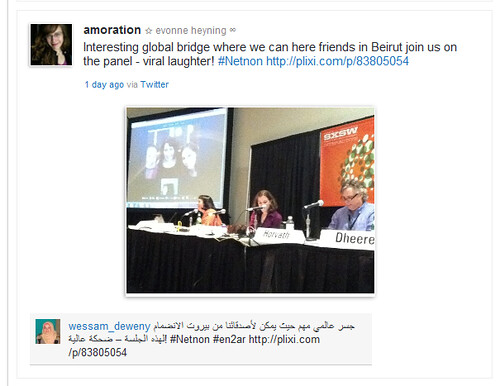
Over the past month, I have been thinking about a couple of different ideas and how to incorporate them into training design to facilitate learning. My questions are:
1. How can we integrate content sharing and audience interaction in the right balance to unleash pearls of wisdom from both audience and the experts on the stage?
2. How can we use graphic facilitation or graphic note taking in real time to deepen understanding of the topic being discussed?
3. How can nonprofits learn from one another across borders without the barrier of translation, particularly online?
4. How can create a back channel or other social media tools that can engage people in the room, but also around the world with an interest in the topic?
5. How do bridge or connect the face-to-face interaction and back channels to leverage learning?
I designed and facilitated “A Global Conversation: Free Agents and Nonprofits in a Networked World” at the SXSWi Interactive over the weekend as an opportunity to experiment with some of these ideas. As many of you know, I’m comfortable with public learning, so using this post to share what I learned.
Balancing Content and Interaction in the Room and Accounting for Different Learning Styles
I don’t like to facilitate a panel from the stage because I think it puts a wall up between the audience and the presenters. I feel it stifles learning. I like to use a wireless mic and roam the audience and ask questions that help create a bridge between the presenters and the audience.
In order to do this, you need to give people a brief context and articulate the interaction rules. This provides the launching pad for learning in the room, and hopefully the back channel. Most importantly, you need panelists who have wisdom and brevity. A good technique is to have each panelist offer a five minute “talk from the heart” presentation sharing their point of view on the topic. The panelists included: Danielle Brigida of the National Wildlife Federation (NWF), Mark Horvath of Invisible People and Jessica Dheere, of Social Media Exchange Beirut in Lebanon.
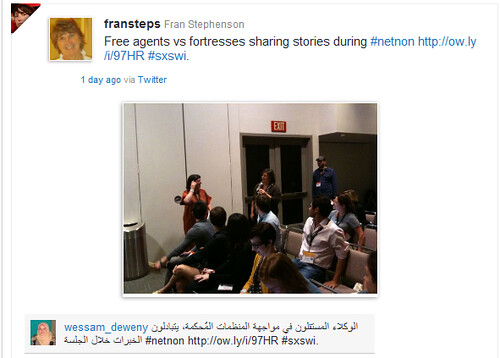
In between each presentation, I asked a conversation starter question for the panelist and then roamed the audience asking folks to share their insights or ask questions. For example, after Danielle talked about her experience working inside of a nonprofit, an audience member who worked for the State Department shared their experience. After Mark Horvath, shared some thoughts based on his experience as a free agent, I asked Craig Newmark, who was in the audience, to offer his advice as a free agent.
When you facilitated a full room conversation like this, you have to be careful to strike the right balance between presentation of content and discussion. At SXSW the sessions are only 60 minutes – and with a design like this, it flies by. Mark Krynsky was not able to share his free agent story because we ran out of time, so I captured it after the panel with my Flip Camera.
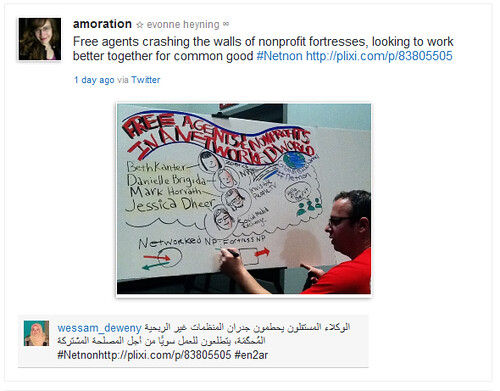
As a visual person, I often get lost when I’m in a full room discussion – even if it is well moderated and there is an overview. Whenever I’m in discussions, I take notes visually having learned the techniques of visual facilitation and mind mapping to help me process. I suspect I’m not alone. That’s why I invited my colleague, Jonny Goldstein, who is an expert using drawings to capture the insights visually as they unfold.
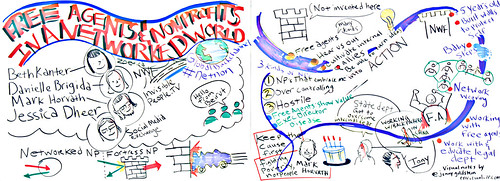
Having a lot of interaction, plus visual facilitation creates an opportunity for richer learning. Debra Askanase has a terrific blog post that captures the many pearls of wisdom that were shared as a result of the design. Amy Sept also has this excellent round up pointing to tweets that resonated. Devon Smith used storify to capture the knowledge shared.
The Back Channel
But how do can you use social media tools creatively to bring in others who have an interest in the topic into the discussion, but are not in the same room? More importantly, how can you bring them in beyond being passive listeners or re-tweeters but engage in the discussion? Finally, having just returned from the Middle East working with social media/NGO trainers, how can you create a global back channel so that language isn’t a barrier to learning?
The session was live tweeted using the #netnon hashtag, but I wanted to go beyond simple live tweeting or re-tweeting. This takes a bit of logistics and a little help from your friends. You have to give everyone a specific job.
Here’s what I set up:
(1) Twitter Advocate, Twitter Monitor, Twit Pict Person, and URL Tosser: Michael Hoffman, Dan Portnoy, Evonne Heyning, Fran Stephens, Kami Huyse, and Katie Shields played these roles – each person was assigned a specific job. The Twitter Advocate is someone who is watching the hashtag stream and can verbalize to the room what a question or comment posted on Twitter.
It was also important to have someone take photos and post them on Twitter so folks online could see what was happening in the room. In addition, I had compiled a page of URLs explaining the topic that could be easily shared in the Twitter stream.
(2) Twitter Channel SME: I invited Shawn Ahmed who was not able to participate in the session, to hang out in the Twitter channel and answer questions. To make a bridge between the room and the virtual, I used his video explaining the concept of networked nonprofits and free agents in the room.

(3) Live Beirut Tweet Up: @naeema and @sdarine from SMEXbeirut organized a live tweetup in Beirut during the same time as our panel which happen to be around midnight. At the last minute, we were able to bring them in via video skype, although the connection and AV set did not a lot us to interact through that channel. Kami Huyse, provided a back up, with live streaming using Qik.
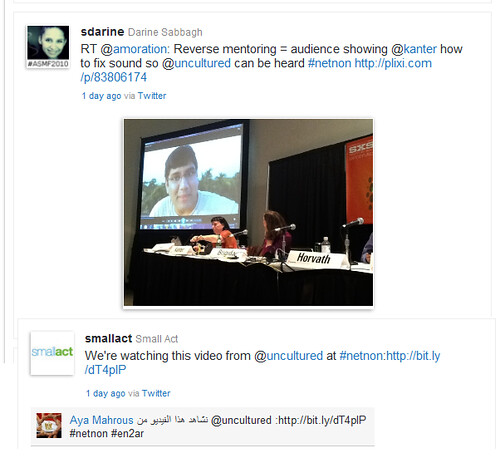
(4) Translated Tweets: Andrea Burton from Meedan, a site that does Arabic/English translations of news stories, was the Middle East Twitter Advocate. She was in the room and set up a curated and translated tweets using curated.by. Andrea was selectingTweets from the #netnon hashtag, adding them to the curated stream and Meedan translators in Egypt were doing the translation into Arabic in real time.
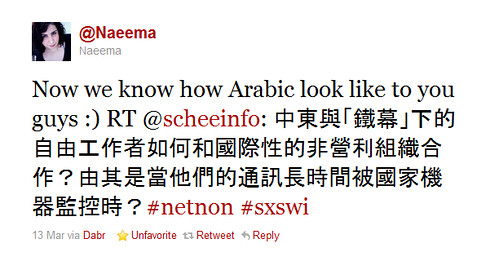
(5) Global Participation: This was a last minute inspiration to test the out the idea of whether or not we could get other people from others parts of the world to participate. My colleagues at TechSoup Global sent an invitation out to folks to participate in the discussion along with The World Time Clock. I also pinged people in my network from different countries.
My takeaways:
1. My mental model for designing and facilitating face-to-face interaction has been Oprah or Phil Donahue, but if I really want to weave the Back Channel and the Face-to-Face together I have to use Cooper Anderson as my mental model. That means I need a T.V. producer who can help with the AV and two laptops. Also, if you’re using videos, wireless mics, and fixed mics – make sure the conference provider has enough audio inputs.
2. I did not promote the invitation to participate very widely. I used my channels, but lightly. If this wasn’t an experiment, I would have had a more intensive promotion plan.
3. I did not have control over the timing of the panel, but if I was doing this outside of a conference, I’d try to find a time when people were awake. Obviously, you can have everyone in every timezone participate at the same time, unless they like to be up late or early.
What have you learned about creating bridges between face-to-face and online for conference sessions or learning events? How they separate but parallel? How do you best ensure good weaving that leads to deeper learning?
